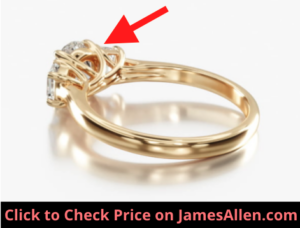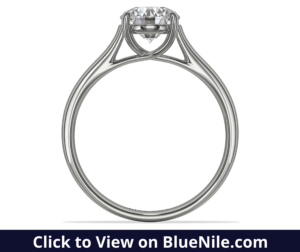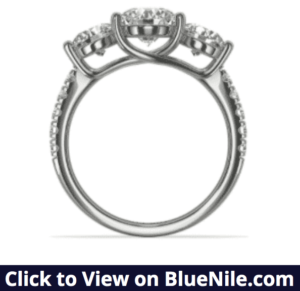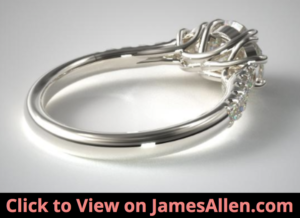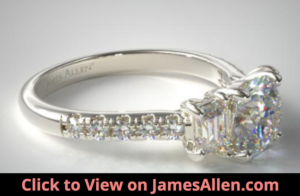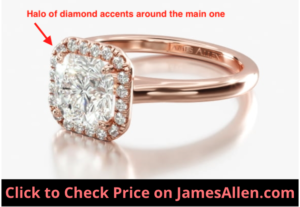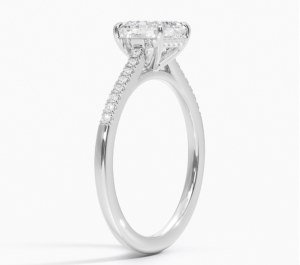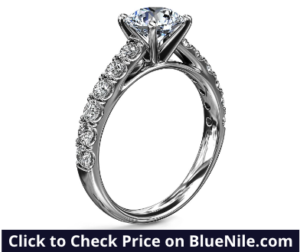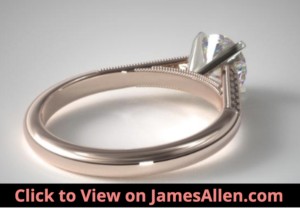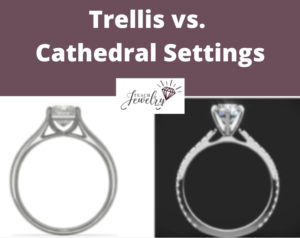
Trellis and cathedral settings both highlight the center diamonds and allow for additional embellishment on engagement rings or other pieces of jewelry.
While many buyers focus on finding the perfect diamond, don’t ignore the impact of a setting on your ring’s overall appearance and performance.
The main difference between trellis and cathedral settings is trellis settings include interweaving prongs that hold the diamond. The distinguishing feature of a cathedral setting is two arches that extend from shank and form triangular gaps. Both are highlighted in a profile view of the ring.
Let’s compare trellis versus cathedral settings, their pros and cons, and how to decide which is right for you.
What is a Trellis Setting?
Trellis settings feature woven, interconnected prongs that extend up from the band to hold the center diamond.
Check out this example.
It’s most apparent when viewed from one side or the other. In the case above, there are three sets of prongs that loop in and out of each other.
In a traditional prong setting, the prongs remain on separate sides of the diamond and don’t cross over each other.
Each prong in a trellis setting weaves past the one on the opposite side, often forming a U shape.
The standard design includes four prongs, where two intersect on each side.
Others include six or eight prongs for added security or extra diamonds.
Pros
Elegance
The focal point of a ring is always the main diamond, but you should also consider how the entire piece appears from every angle.
As the wearer, you often view it from the top down. Even an alternative style such as a trellis setting looks similar to other types of settings from that angle.
Where the trellis setting stands out is when it’s viewed from the side. Its profile shows the interwoven prongs that reach up to hold the diamond.
In the illustration below, that view highlights the two sets of interwoven prongs.
If you rotate it 180 degrees, it appears identical on the other side.
It adds elegance to a part of your ring that’s normally neglected in favor of the top-down view of your diamond. In fact, when others see your ring, they’re most often viewing it from the side.
Instead of typical designs such as four separate prongs or even a split-shank, the intersecting prongs on a trellis setting add a unique element not found in other ways of holding a diamond.
Room for Multiple Diamonds
The most common design for an engagement ring setting leaves room for one main diamond on top.
Some feature accents and other gemstones along the shank or surrounding the center diamond, but buyers are often deciding which setting best displays a single diamond.
One of the advantages of trellis settings is it can hold multiple diamonds in a prominent position.
Check out the three-stone trellis setting below.
The diamond in the middle is slightly larger than the other two, but each is held by prongs that overlap
As another example, five-stone settings often feature the interconnected prongs of a trellis setting.
One large diamond is flanked on either side by two smaller ones, and all the prongs form an “X” shape at the top of the band.
Long, thin prongs stretch from one side of the main diamond to the far side of the adjacent one. This pattern plays out with each prong and diamond so each one is held by U-shaped prongs.
If you’re looking for a design that’s fit to hold several diamonds on top, consider a trellis setting.
Support for Prongs
Prongs are a popular choice for securing a diamond, but one of its downsides is security.
The thin metal prongs can bend backward and cause the diamond slip out or loosen over time.
Another benefit of trellis settings is they provide more support for prongs. The way they weave in and out of each other makes each one more secure because it’s held in place by another prong.
In the 14k white gold setting below, notice the significant number of prongs holding the diamond.
That provides far more support compared to a traditional four-prong setting.
You should still avoid wearing a ring during physical activity to avoid the potential for it to snag on clothing or hair, but the extra support from the interconnected prongs minimizes this issue.
Room for Ring Enhancements
If you choose a trellis setting, you’ll still have the opportunity to embellish the ring with bead- or channel-set diamonds or other accents.
The unique features of a trellis setting are primarily at the top of the band, so the rest of it is open for enhancements, even if it’s a thin knife edge ring.
This design features pavé diamonds that run halfway down each side of the ring.
Or the shank can feature round brilliant diamond accents cascading down each side in a channel.
It’s an effective way to add sparkle to the ring without the price premium required to increase the carat weight of the main diamond.
You can also opt for milgrain, which are tiny metal beads or dots placed along the band. It’s common on antique jewelry and doesn’t add significant cost to the ring.
There are trellis settings available for solitaire designs with no embellishments, but consider how more gemstones on your ring can complement the jewelry.
Cons
Cleaning
Settings with intricate designs are more difficult to clean. This is true of trellis settings because of the crevices formed by the woven prongs.
Notice how in the setting below, there are small nooks where dirt and debris can trap over time.
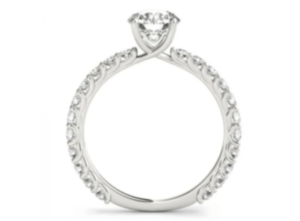
These areas are hard to reach when cleaning and can allow it to accumulate.
Because of the tendency for trellis settings to collect grime, I recommend having it professionally cleaned once or twice per year.
It will prevent debris from wearing down the metal and shortening the lifespan of your setting.
Security
Any setting that uses prongs to hold the diamond is less secure than other types.
Even though the prongs on a trellis setting support each and can prevent the diamond from falling out if one is loosened, if security is your priority, choose another setting.
For example, bezel settings feature a ring of metal that wraps around the diamond.
It’s considered the most secure setting because the entire outer edge of the diamond is protected by it.
No matter the angle the diamond is hit, the bezel setting will embrace the impact. The downside is it doesn’t leave its facets as exposed to collect and return light.
Trellis settings, on the other hand, leave the diamond vulnerable because there are often only four prongs. If you’re looking to improve the security of a trellis setting, choose one that grasps the diamond with six prongs.
Or you can protect the center diamond with a halo of accents that provide another layer of security.
It’s less of a problem if one of the outer diamonds is damaged compared to the main one.
Fewer Options
There are fewer options available from jewelry retailers for trellis versus cathedral settings.
Trellis settings are a subset of prong settings, so you won’t find the wide variety for sale that you’ll find if you choose a broader category.
Even if you narrow your search to any type of prong setting, there are an endless number on the market, such as:
- Double claw prong
- Basket settings
- Shared prongs
- V-prongs
Within each of these settings, there are variations that include the interwoven trellis prongs, but there are far more without that unique design.
What is a Cathedral Setting?
Cathedral settings feature two arches that extend from the top of the shank to support the prongs that hold the diamond.
I’ve posted the image below at an angle that showcases its defining design.
If you rotate the image to view it from the profile, both gaps are apparent.
The arches form those triangular gaps in the setting to give it a sense of elegance as it holds whichever cut you choose as your engagement ring diamond.
Prongs aren’t the only way to hold a diamond in a cathedral setting.
There are variations that include a bezel setting, where the arches extend to both sides of the metal wrapping around the gem.
Pros of Cathedral Settings
Prominence to the Center Diamond
Most cathedral settings are high-set. The diamond sits high off your finger, which gives it more prominence compared to low-set rings.
The extra height allows it to capture more light and reflect it back to the viewer, enhancing the diamond’s brilliance, which is similar to a Tiffany setting.
This is especially important for diamonds over two carats. It creates enough separation between your finger and the large diamond, so you don’t experience discomfort.
Variety of Designs
There are a variety of designs available within a cathedral setting. They’re fit to hold any diamond cut, whether marquise, oval, round, or composite diamonds.
The distinguishing feature isn’t how the diamond itself is held, but instead how the prongs or bezel are supported by its arches.
That’s why you’ll often find cathedral settings available with many types of prong settings such as flat-tab or single claw prongs.
You can also embellish the shank on a cathedral setting with multiple rows of pave diamonds, channel-set diamonds, or milgrain.
In the example below, pavé-set round cuts sit in the 14K white gold setting.
They’re placed in a U-shape, and six cascade down each side of the center diamond.
But one of the most popular choices for cathedral settings is a simple solitaire ring. Because the setting is designed to give prominence to the center diamond, many buyers don’t want to detract from its brilliance.
Cons
Susceptible to Snagging
The prongs on cathedral and non-cathedral settings are susceptible to snagging, but it’s especially true for the former.
High-set diamonds with prongs are more vulnerable to catch on hair, furniture, and clothing during everyday activities. When the prongs snag, they can be torn loose or bend backwards, which leaves the diamond prone to fall out.
One solution to this problem is to choose a low-setting. Some cathedral settings placed the diamond and its prongs much closer to your finger, so it’s less likely to snag.
Fills with Debris
If you’re comparing cathedral versus trellis settings, you should know they both fill with debris more often than other settings.
Cathedral settings feature the same small crevices and nooks found in trellis settings, which accumulate dirt and grime with use. You can identify that trait in this setting.
Over time, this can wear down the metal and damage the diamond, so you should have it cleaned at least once per year.
There are at-home solutions to cleaning your ring, but a professional can restore its shine and ensure the diamonds aren’t damaged during the process.
How to Decide Between Trellis and Cathedral Settings
Either setting can be the right choice for buyers looking for the perfect complement to their diamond.
If you’re comparing trellis versus cathedral settings, here are some guidelines to help you decide.
Choose a trellis setting if:
- You’re looking for a way to enhance the profile of your ring
- You want a three- or five-stone setting
- It’s important to you that the prongs have multiple areas of support
- You want a unique setting that still allows for diamonds on the shank
Consider a cathedral setting for your diamond if:
- You want to give the diamond prominence with a high setting
- You’re searching for a setting that offers a variety of designs
- The look of the arches and triangle gaps in the ring are appealing
Both settings come in a variety of metals, from yellow and rose gold to platinum.
Examine how their trellis and cathedral settings fit with your choice of diamond, so you can select the right ring for you.

Jacob Clarke
Jacob Clarke is the founder of TeachJewelry.com.
He earned an Applied Jewelry Professional Diploma from the Gemological Institute of America (GIA) and now brings you essential information about diamonds, settings, and more.
Jacob has consulted with leading jewelry brands, and his work has been cited in Clean Origin, Diamond Nexus and industry publications.
He's also a member of the International Gem Society.
He enjoys discussing jewelry with readers, so contact him with any questions at jacob.clarke@teachjewelry.com.

